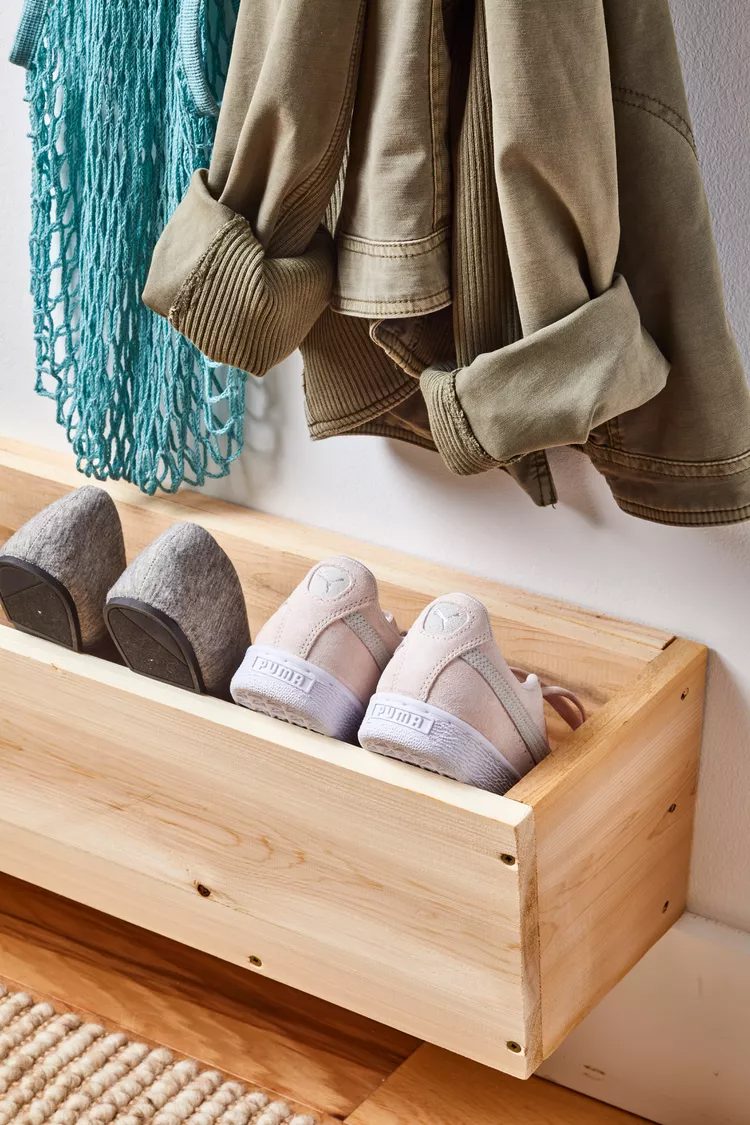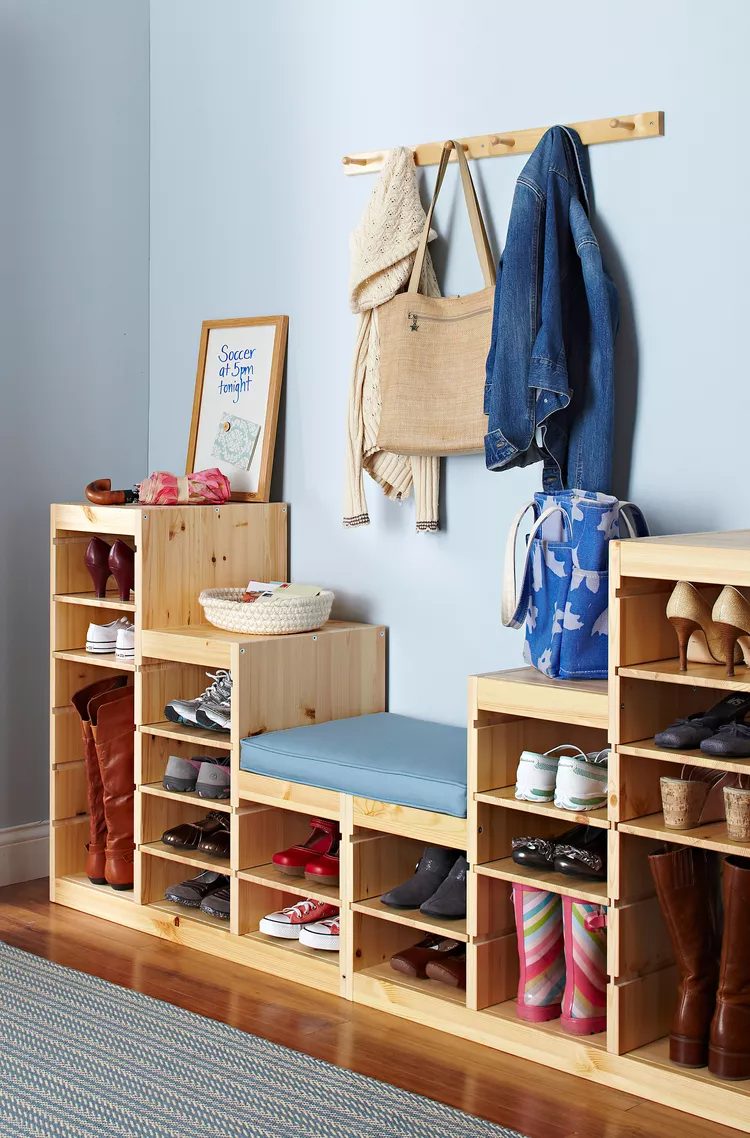From winter boots to stilettos, these organizing methods will keep all your shoes in top condition.
When it comes to shoes, finding the right organization method can be tricky. Since they’re usually both abundant and bulky, it’s important to make the room and create a system for storing them. To help you cut shoe clutter and find your favorite pair when you need them, I’m sharing the best shoe organizing methods I’ve learned as a professional organizer.

Create a plan that works for your space and your specific shoes, clears clutter from your walkways, and keeps your shoes in better shape. Learn the best methods and tools to finally get a handle on your footwear with these straightforward shoe organization ideas.

1. Declutter Your Shoe Collection
Before embarking on any home organization project, aim to get rid of the items you no longer want or need. This allows you to see the actual quantity of things you’re keeping and make more informed decisions about where and how to organize them. In this case, donate or toss the shoes that no longer fit, are no longer your style, aren’t comfortable, or are damaged beyond repair.
This is also a great time to identify which shoes could use a proper cleaning. That way, you’ll be putting away clean, ready-to-wear shoes once you start organizing.
2. Sort Shoes into Categories
Once you’re left with only the pairs of shoes you’re keeping, separate them by type. Assemble your sneakers, sandals, heels, and so on into sections to get a good idea of what your best storage solutions will be. (More on that later!) Sort shoes by season, as well as casual versus formal, and daily use vs. shoes that you don’t wear often.
3. Assess your Storage Space
Next, take a look around your home to determine where your shoes would fit best. You may very well have to get creative especially if you’re working with limited space for organizing. In an ideal world, all of your shoes should be stored together but, more than likely, you’ll need or want to divide them into various areas. This is where the organizational element comes in: It’s best to keep like kinds of shoes together, so you can easily find the right pair when you want them. All sneakers should be stored together, and all winter footwear should be kept in the same area, etc. The following ideas will help you establish the most effective system for your household.

4. Tackle Everyday Shoes
If you’re kicking the same pair of sneakers or slides on and off each day, stuffing them away in an upstairs closet will be pretty inconvenient. These few pairs of shoes should have a designated spot by the front door, mudroom, garage, or wherever is your usual exit and entrance to the house. As the weather changes and you’re not wearing them as often, then they can move into a different space or be stored away for the season altogether. Keep that in mind as you’re piecing your organization plan together.
Use a shoe rack: A standard two or three tier rack is a simple solution and best for those everyday shoes by the front door since they don’t hold too many at a time. Use one for gym sneakers, work boots, or whatever you throw on to walk the dog or dig in the garden. For large families, invest in a tall vertical rack that fits everyone’s favorite pairs.
Install a standing shoe cubby: A close alternative to a rack is a cubby that has individual slots for shoes as opposed to shelves. The benefit of something like this is that it keeps pairs definitively separated and tucked into place. The downside is that many of the cubbies are too small to fit chunky shoes like booties and boots. Try this method by the front door if most of the shoes are on the slimmer side.
Store them in the coat closet: An over-the-door shoe organizer can work well for flat shoes in the coat closet. Hook it over the inside of the door and arrange pairs either in order of how often you wear them or eye level for different family members.
Use a boot tray: If inclement weather is common in your area, you should have an appointed spot to stash your wet or dirty boots. Find a tray in a material like rubber or a rack with vertical rods to collect snow and leaves or let them dry upside down. Keep it out of the way by placing it in the mudroom or garage.
5. Find a Home for Formal Shoes
Conversely, you don’t need to be tripping over the special occasion shoes on a daily basis. The dressy pair of heels that you pull out once or twice a year should not take up prime real estate in the entryway. Instead, tuck these pairs away in an area of your primary closet, or on a shelf in the spare bedroom closet. Keeping all your formal shoes in one place will help you find the right match as you get dressed for a wedding or fancy event.
Of course, if you have a job that requires you to dress up or wear heels every day, this advice won’t be practical for you. Instead, you can treat these as your everyday shoes and store them somewhere that’s easy to access.
Use a heel rail: If you’re the DIY type, you might like this idea to organize a plethora of high heels. Install rows of shallow picture shelves on a blank bedroom or walk-in closet wall and hang them off the edge. This works best for tall stiletto or block heels as opposed to wedges or low pumps.
Use protective shoe boxes: No, we’re not talking about the original box the shoes came in, but rather a box that will allow your shoes to breathe and stack easily. These are ideal for the special shoes that require extra protection. Using the top shelf in your bedroom closet, pile a set of boxes as high as they’ll go and as far wide as you need to fit as many shoes as you can in a small amount of space. Look for clear shoe boxes with ventilation holes and drop front lids so you don’t have to disturb the entire stack to grab a pair on the bottom.
6. Stash Shoes Away Seasonally
If you don’t have the room to keep all of your shoes in the closet year round, find a few storage options and rotate your shoes out seasonally. For example, winter boots can live under the bed in the hot summer months. When the seasons change, take out the boots and place flip flops and sandals in storage bins.
Store shoes under the bed: Since this storage area isn’t always easy to access, it’s a great storage spot for shoes you won’t need for several months. Find an under-bed storage container specific for shoes or boots and stow away the ones you don’t wear as often. Alternatively, you can place shoes into individual drawstring bags or stuff boots and then layer them into a lidded (and labeled) tote. Tuck it onto a shelf in the basement, attic, or wherever you feel comfortable with them living until the weather changes again.
Use boot clip hangers: For mid calf to over the knee boots, specifically those made of suede and other malleable materials, consider hanging them from clips made specifically for this purpose. This keeps them off the floor and from flopping over. Most are designed to comfortably attach to the tops without causing damage. However, you might want to skip this idea if you’re worried about the clips creating indents on your investment pieces, such as on a pair of leather boots.

7. Choose the Best Shoe Organizers
Once you’ve set your shoe categories and have an idea of where you want to store them, it’s time to organize each designated shoe storage spot. The following ideas will help guide you to make the most of your space in accordance with the shoes you own.
Use a hanging shoe cubby: If the back of a closet door isn’t an option, but you have a little wiggle room on the rod, try a hanging shoe organizer to sort out the different pairs in a vertical row. Once again, the caveat is that these are not designed for taller or bigger styles so use it to corral flip flops, slip ons, and the like.
Use decorative baskets on a shelf: Rather than take up precious space on a rack or in a box, use a simple oversized basket to contain casual shoes. Assign one to each family member and place them in the mudroom so everyone can toss in their sneakers or sandals. Turn it into a game for the little ones as a way to get them to keep their things tidy.
Buy a storage bench: Small spaces benefit greatly from multipurpose furniture. A bench or ottoman with hidden storage makes an excellent spot for shoes because it keeps them organized and gives you a place to sit while tying your laces. Need more than a bench in the entryway? Consider building a landing zone complete with underneath shoe storage.
